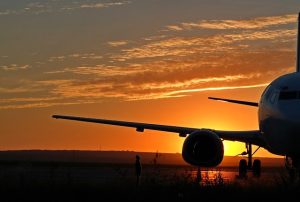
Ever notice hinge-like surfaces on the edges of an airplane’s wings? Known as wing flaps, they can affect flight forces like lift and drag. Most wing flaps are found on the trailing edge of an airplane’s wings. Pilots can activate them from inside the cockpit to change the airplane’s lift or drag.
Wing Flags During Takeoffs
Many pilots will extend their airplane’s wing flaps during takeoffs. Extended flaps are angled to the wings on which they are mounted. Wing flaps can either be extended, or they can be lowered. During takeoffs, though, many pilots will extend their airplane’s wing flaps.
Extended wing flaps offer several advantages for takeoffs. They minimize ground roll, for instance. Airplanes can achieve sufficient lift faster with their wing flaps extended. Using extended wing flaps also reduces drag. Airplanes produce less drag when their wing flaps are extended, which can further streamline takeoffs.
Wing Flaps During Landings
Pilots may partially or fully extend their airplane’s wing flaps during landings as well. With the wing flaps extended, airplanes benefit from a lower stall speed. This means pilots can slow down as they approach the airport — without stalling, of course.
Wing flaps affect both lift and drag, and these forces affect the way in which pilots land their airplanes. As lift and drag increase, pilots can use a slower speed to approach and land their airplanes.
An excessively high lift and drag, though, can make it difficult for pilots to land in crosswinds. If crosswinds are a concern, pilots may raise the airplane’s wing flaps.
The Different Types of Wing Flaps
All wing flaps consist of hinge-like surfaces on the edges of an airplane’s wings. But there are many different types of wing flaps, each of which features a unique design.
One of the most common types of wing flaps is the plain flap. It uses a simple design consisting of a hinged surface on the trailing edges of the wings. There are so slotted flaps. Slotted flaps are characterized by a gap. They look like plain flaps, but only slotted flaps have an open space between them and the wings on which they are mounted. Other common types of wing flaps include split, fowler, junkers and Krueger.
Pilots may extend their airplane’s wing flaps at cruising altitude, but wing flaps are typically used for takeoffs and landings.



